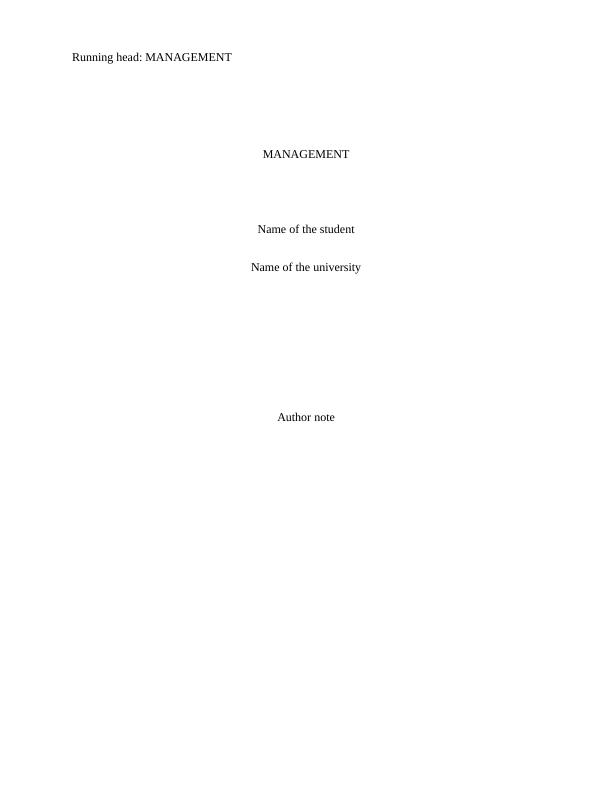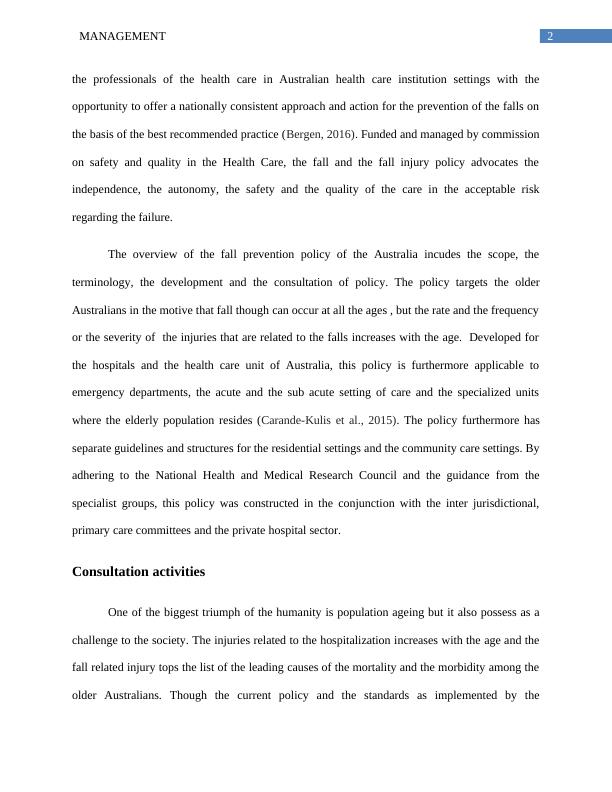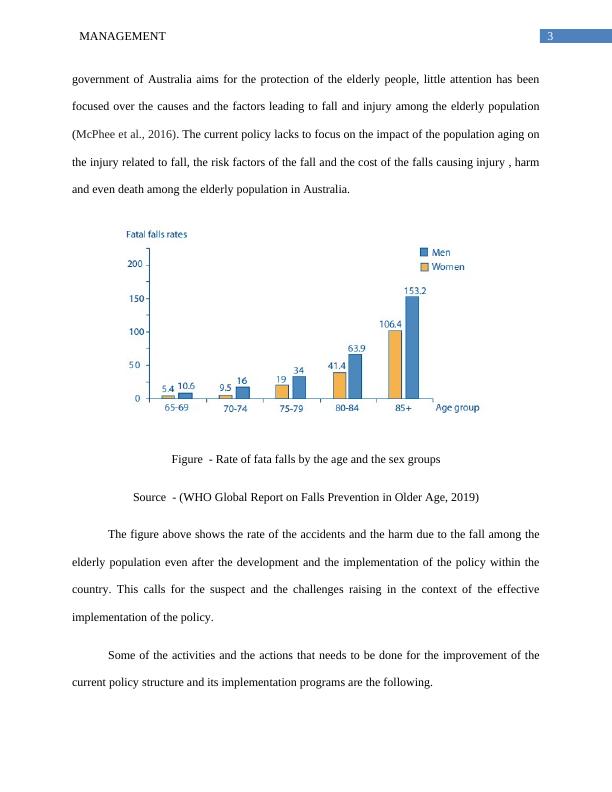Management of Falls and Fall Prevention Policy for Elderly Population
21 Pages4070 Words93 Views
Added on 2023-03-21
About This Document
This report analyzes the current policy and legislation on elderly fall prevention, summarizes the incidents of falls among the elderly population, and identifies the effectiveness of the current legislation and policy. It also recommends actions and consultation activities for improving the policy for public wellness and benefit.
Management of Falls and Fall Prevention Policy for Elderly Population
Added on 2023-03-21
ShareRelated Documents
Running head: MANAGEMENT
MANAGEMENT
Name of the student
Name of the university
Author note
MANAGEMENT
Name of the student
Name of the university
Author note

MANAGEMENT 1
Introduction
Falls are very much prominent within the external reasons for unintentional injuries.
These lead to consequent injuries and are a major concern regarding the public health which
require medical attention. According to (), approximately more than 28-36% of the people
belonging to the aged population who are more than 65 of age fall each year while those with the
age range of 70 years and above falls 32 to 42%. The frequency of the rate of the falls increases
with the level of the frailty and age. As per the analysis and the research by (Preventing Falls and
Harm From Falls in Older People Best Practice Guidelines for Australian Hospitals, 2019) older
people who lives in the nursing home falls more than the those who resides in the community.
World Health Organization estimated more than 40% of the fall accounts to injury deaths among
the elderly population with the age range more than 65 years. The aim of the report is to analyze
the current policy and the legislation on elderly fall prevention (Falls prevention :: SA Health,
2019). The report furthermore targets to summarize the incidents of the falls among the elderly
population and how these are affecting the health and the wellbeing status of the elderly
population of the globe. The statement of purpose of tis report is to identify the effectiveness of
the current legislation and the policy regarding the fall prevention among the elderly population
and the recommended actions and the consultation activities that is required for the improvement
of the policy for the public wellness and benefit.
Overview of current policy
Fall and fall injury prevention policy is the current legislative measure by the government
of the country of Australia. The guidelines of the policy targets to improve the safety and the
quality of the care for the older people residing in the country. This policy has been designed for
Introduction
Falls are very much prominent within the external reasons for unintentional injuries.
These lead to consequent injuries and are a major concern regarding the public health which
require medical attention. According to (), approximately more than 28-36% of the people
belonging to the aged population who are more than 65 of age fall each year while those with the
age range of 70 years and above falls 32 to 42%. The frequency of the rate of the falls increases
with the level of the frailty and age. As per the analysis and the research by (Preventing Falls and
Harm From Falls in Older People Best Practice Guidelines for Australian Hospitals, 2019) older
people who lives in the nursing home falls more than the those who resides in the community.
World Health Organization estimated more than 40% of the fall accounts to injury deaths among
the elderly population with the age range more than 65 years. The aim of the report is to analyze
the current policy and the legislation on elderly fall prevention (Falls prevention :: SA Health,
2019). The report furthermore targets to summarize the incidents of the falls among the elderly
population and how these are affecting the health and the wellbeing status of the elderly
population of the globe. The statement of purpose of tis report is to identify the effectiveness of
the current legislation and the policy regarding the fall prevention among the elderly population
and the recommended actions and the consultation activities that is required for the improvement
of the policy for the public wellness and benefit.
Overview of current policy
Fall and fall injury prevention policy is the current legislative measure by the government
of the country of Australia. The guidelines of the policy targets to improve the safety and the
quality of the care for the older people residing in the country. This policy has been designed for

2MANAGEMENT
the professionals of the health care in Australian health care institution settings with the
opportunity to offer a nationally consistent approach and action for the prevention of the falls on
the basis of the best recommended practice (Bergen, 2016). Funded and managed by commission
on safety and quality in the Health Care, the fall and the fall injury policy advocates the
independence, the autonomy, the safety and the quality of the care in the acceptable risk
regarding the failure.
The overview of the fall prevention policy of the Australia incudes the scope, the
terminology, the development and the consultation of policy. The policy targets the older
Australians in the motive that fall though can occur at all the ages , but the rate and the frequency
or the severity of the injuries that are related to the falls increases with the age. Developed for
the hospitals and the health care unit of Australia, this policy is furthermore applicable to
emergency departments, the acute and the sub acute setting of care and the specialized units
where the elderly population resides (Carande-Kulis et al., 2015). The policy furthermore has
separate guidelines and structures for the residential settings and the community care settings. By
adhering to the National Health and Medical Research Council and the guidance from the
specialist groups, this policy was constructed in the conjunction with the inter jurisdictional,
primary care committees and the private hospital sector.
Consultation activities
One of the biggest triumph of the humanity is population ageing but it also possess as a
challenge to the society. The injuries related to the hospitalization increases with the age and the
fall related injury tops the list of the leading causes of the mortality and the morbidity among the
older Australians. Though the current policy and the standards as implemented by the
the professionals of the health care in Australian health care institution settings with the
opportunity to offer a nationally consistent approach and action for the prevention of the falls on
the basis of the best recommended practice (Bergen, 2016). Funded and managed by commission
on safety and quality in the Health Care, the fall and the fall injury policy advocates the
independence, the autonomy, the safety and the quality of the care in the acceptable risk
regarding the failure.
The overview of the fall prevention policy of the Australia incudes the scope, the
terminology, the development and the consultation of policy. The policy targets the older
Australians in the motive that fall though can occur at all the ages , but the rate and the frequency
or the severity of the injuries that are related to the falls increases with the age. Developed for
the hospitals and the health care unit of Australia, this policy is furthermore applicable to
emergency departments, the acute and the sub acute setting of care and the specialized units
where the elderly population resides (Carande-Kulis et al., 2015). The policy furthermore has
separate guidelines and structures for the residential settings and the community care settings. By
adhering to the National Health and Medical Research Council and the guidance from the
specialist groups, this policy was constructed in the conjunction with the inter jurisdictional,
primary care committees and the private hospital sector.
Consultation activities
One of the biggest triumph of the humanity is population ageing but it also possess as a
challenge to the society. The injuries related to the hospitalization increases with the age and the
fall related injury tops the list of the leading causes of the mortality and the morbidity among the
older Australians. Though the current policy and the standards as implemented by the

3MANAGEMENT
government of Australia aims for the protection of the elderly people, little attention has been
focused over the causes and the factors leading to fall and injury among the elderly population
(McPhee et al., 2016). The current policy lacks to focus on the impact of the population aging on
the injury related to fall, the risk factors of the fall and the cost of the falls causing injury , harm
and even death among the elderly population in Australia.
Figure - Rate of fata falls by the age and the sex groups
Source - (WHO Global Report on Falls Prevention in Older Age, 2019)
The figure above shows the rate of the accidents and the harm due to the fall among the
elderly population even after the development and the implementation of the policy within the
country. This calls for the suspect and the challenges raising in the context of the effective
implementation of the policy.
Some of the activities and the actions that needs to be done for the improvement of the
current policy structure and its implementation programs are the following.
government of Australia aims for the protection of the elderly people, little attention has been
focused over the causes and the factors leading to fall and injury among the elderly population
(McPhee et al., 2016). The current policy lacks to focus on the impact of the population aging on
the injury related to fall, the risk factors of the fall and the cost of the falls causing injury , harm
and even death among the elderly population in Australia.
Figure - Rate of fata falls by the age and the sex groups
Source - (WHO Global Report on Falls Prevention in Older Age, 2019)
The figure above shows the rate of the accidents and the harm due to the fall among the
elderly population even after the development and the implementation of the policy within the
country. This calls for the suspect and the challenges raising in the context of the effective
implementation of the policy.
Some of the activities and the actions that needs to be done for the improvement of the
current policy structure and its implementation programs are the following.

4MANAGEMENT
Apart from taking steps and actions by the government of the country regarding proper
implementation of the fall and the fall prevention policy for the elderly population , it is
important for the health care agencies and the hospitals to take up trainings and to spread the
knowledge regarding the residential care settings for the elderly person living in their home
(Sherrington et al., 2017). Consultation activities furthermore includes the consideration of the
fact that the exponential rate or the tendency of the fall increase with the changes of the age
related biology. The actions furthermore needs to trigger the potential causes of the substantial
increase of the fall and the fall related injury at the alarming rate among the residence which is
higher as compared to the hospitals.
One of the most essential consultation activities that the government of the country needs
to update regarding their fall prevention settings for the old age is the monthly visit and
checkups for the residential aged population in the country by the hospital and the health care
tem. This new and improved actions needs to be added with the policy since this will help the
aged population from fall and the fall related chronic injury (Muir-Hunter & Wittwer, 2016). The
actions furthermore includes the need for the consideration of the biological risk factors that
embraces the characteristics of the each and every individuals which pertains to the human body.
Factors such as decline of the cognitive, physical and the affective capabilities with the co-
morbidity and the association with the chronic illness needs to be considered.
Literature Review
The rate of the admission in the hospital due to the fall and the fall related injury among
the people with the age of 60 and above in Australia ranges from 1.6 to 3.0 per 10000
population. According to Houry et al. (2016) falls leads to mild and severe injuries and these are
Apart from taking steps and actions by the government of the country regarding proper
implementation of the fall and the fall prevention policy for the elderly population , it is
important for the health care agencies and the hospitals to take up trainings and to spread the
knowledge regarding the residential care settings for the elderly person living in their home
(Sherrington et al., 2017). Consultation activities furthermore includes the consideration of the
fact that the exponential rate or the tendency of the fall increase with the changes of the age
related biology. The actions furthermore needs to trigger the potential causes of the substantial
increase of the fall and the fall related injury at the alarming rate among the residence which is
higher as compared to the hospitals.
One of the most essential consultation activities that the government of the country needs
to update regarding their fall prevention settings for the old age is the monthly visit and
checkups for the residential aged population in the country by the hospital and the health care
tem. This new and improved actions needs to be added with the policy since this will help the
aged population from fall and the fall related chronic injury (Muir-Hunter & Wittwer, 2016). The
actions furthermore includes the need for the consideration of the biological risk factors that
embraces the characteristics of the each and every individuals which pertains to the human body.
Factors such as decline of the cognitive, physical and the affective capabilities with the co-
morbidity and the association with the chronic illness needs to be considered.
Literature Review
The rate of the admission in the hospital due to the fall and the fall related injury among
the people with the age of 60 and above in Australia ranges from 1.6 to 3.0 per 10000
population. According to Houry et al. (2016) falls leads to mild and severe injuries and these are

5MANAGEMENT
some of the underlying causes behind the emergency departmental visits. The author in his
research paper highlighted the fact that more than 50% of the injury related to the hospital was
among the population over the age group of 65 years. Some of the major underlying causes for
the fall injured hospital admission are the traumatic brain injuries, the hip fracture and the upper
limb injuries.
As per the analysis of Verma et al. (2016) falls and the fall related to injury is the occurrence of
the complex interaction of the risk factors. Some of the main factors of the risk reflects the
multitude of the health determinants that possibly directly or indirectly affect the wellbeing of
the aged population.
Figure - Risk Factor model in the context of the fall among the older population
Source – (WHO Global Report on Falls Prevention in Older Age, 2019)
some of the underlying causes behind the emergency departmental visits. The author in his
research paper highlighted the fact that more than 50% of the injury related to the hospital was
among the population over the age group of 65 years. Some of the major underlying causes for
the fall injured hospital admission are the traumatic brain injuries, the hip fracture and the upper
limb injuries.
As per the analysis of Verma et al. (2016) falls and the fall related to injury is the occurrence of
the complex interaction of the risk factors. Some of the main factors of the risk reflects the
multitude of the health determinants that possibly directly or indirectly affect the wellbeing of
the aged population.
Figure - Risk Factor model in the context of the fall among the older population
Source – (WHO Global Report on Falls Prevention in Older Age, 2019)

End of preview
Want to access all the pages? Upload your documents or become a member.
Related Documents
Falls Prevention among elderly individuals Assignment PDFlg...
|21
|3680
|29
Preventing Falls in Residential Aged Care Settings: Policy Direction and Stakeholder Engagementlg...
|21
|5755
|430
Falls Prevention and Management for Older Patients in Acute & Sub-acute Care Facilities to Active Aging Systemlg...
|13
|3425
|298
Policy Critique Assessment 2022lg...
|17
|3674
|17
Physical Exercise Regime for Accidental Fall Prevention Among Older Adultslg...
|9
|3596
|366
Fall Injury Prevention in Older People Policylg...
|9
|4090
|233
